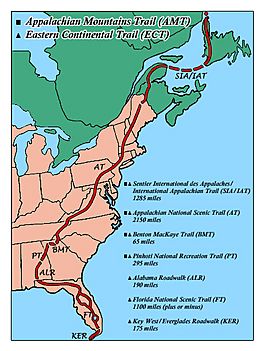International Appalachian Trail facts for kids
Quick facts for kids International Appalachian Trail |
|
|---|---|

This map does not show trails through Nova Scotia or Prince Edward Island nor the more recent additions on the eastern side of the Atlantic.
|
|
| Length | 1,900 mi (3,100 km) |
| Location | Maine, United States, and Canada |
| Trailheads | Mount Katahdin – Belle Isle |
| Use | Hiking |
| Highest point | Mount Katahdin |
| Lowest point | Cap Gaspé |
The International Appalachian Trail (IAT) is a very long hiking trail. It was first planned to connect the northern end of the Appalachian Trail in Mount Katahdin, Maine, to Belle Isle in Newfoundland and Labrador. This island is the most northeastern point of the Appalachian Mountains.
The IAT was first seen as an extension of the famous Appalachian Trail. However, it soon became its own special trail. Today, the IAT has grown far beyond North America. It now includes trails in many parts of Europe and North Africa. This expansion connects places that were once part of the same ancient mountain range.
Contents
Trail History
The idea for the International Appalachian Trail came from Richard Anderson in 1994. He was a biologist from Maine. He wanted to create a trail through parts of the Appalachian Mountains in Maine, New Brunswick, and Quebec. These areas were not covered by the original Appalachian Trail.
Building the trail took place during the late 1990s. The first person to hike the entire IAT was John Brinda in 1997. He also hiked a longer trail called the Eastern Continental Trail. This trail starts in Key West, Florida, and ends at Cap Gaspé in Quebec.
In 2003, people suggested adding a section in Newfoundland and Labrador. This part of the trail is still being built. When it is finished, it will add about 1,200 kilometers (745 miles) to the IAT. The first section of the Newfoundland trail opened on September 23, 2006.
Exploring the IAT Route
The IAT starts in Maine, heading northeast from Mount Katahdin. It goes towards Mars Hill and then follows the U.S.-Canada border. The trail crosses into Perth-Andover, New Brunswick at Fort Fairfield, Maine.
In New Brunswick, the trail follows the Tobique River valley. It then goes up to Mount Carleton. After that, it crosses the Miramichi Highlands. The trail then enters Quebec, following the Restigouche River valley. It continues along the Chic-Choc Mountains on the Gaspé Peninsula. The trail ends at the easternmost point of the peninsula, Cap Gaspé in Forillon National Park.
From Cap Gaspé, the IAT jumps over to a small section in Prince Edward Island and Nova Scotia. Then, it crosses the Gulf of Saint Lawrence to Newfoundland. The trail starts again at Channel-Port aux Basques. It follows the west coast of Newfoundland up the Great Northern Peninsula. The trail finishes at Cape Bauld, the island's northern tip. From there, the IAT crosses the Strait of Belle Isle to Belle Isle. This is the northern end of the Appalachian Mountain chain.
Connecting Continents: Europe and North Africa
Scientists have found that the Appalachian Mountains are connected to mountains in Western Europe and North Africa. These mountains were all part of a huge ancient mountain range. This range formed when giant landmasses collided over 250 million years ago. This happened when the supercontinent Pangaea was created.
When Pangaea broke apart, pieces of this old mountain range stayed on different continents. These continents then drifted to where they are today. Because of this amazing geological link, people are working to extend the IAT into Western Europe and North Africa.
In April 2010, Greenland became the seventh part of the International Appalachian Trail. Its route is on the Nuussuaq Peninsula. This area is near Uummannaq Fjord.
After Greenland, Scotland joined in June 2010. The West Highland Way became the first IAT trail in Europe. In October 2010, nine more places joined the IAT. These included Norway, Sweden, Denmark, the Netherlands, England, Ulster-Ireland, Wales, the Faroe Islands, and Iceland. Spain also joined the IAT in 2010.
Trail Highlights
The International Appalachian Trail passes through many beautiful parks. Here are some of them:
Canada
- Mount Carleton Provincial Park (New Brunswick)
- Gaspésie National Park (Quebec)
- Forillon National Park (Quebec)
- Sir Richard Squires Provincial Park (Newfoundland)
- Ship's Arm Provincial Park (Newfoundland)
- Gros Morne National Park (Newfoundland)
Europe
- The Giant's Causeway, Northern Ireland
- Pembrokeshire Coast National Park, Wales
- Loch Lomond and The Trossachs National Park, Scotland


